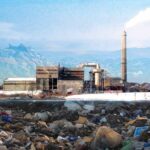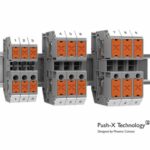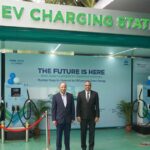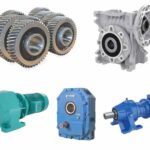
What’s your comment on the Indian government’s mission to achieve Net Zero carbon emissions by 2070 through renewables’ capacity additions?
Renewables are challenging thermal. The government has ambitious targets for renewables. Coal usage will become less in India in times to come but it will remain as solar and wind cannot be available all the time. Coal will continue to be the baseload for some time to come.
More focus is required on renewables. There is a need to have a clear policy on battery storage solutions for renewable energy. Earlier, there were power shortages, but now that India has achieved near adequacy, there is a need to focus on quality of reliable power. Battery storage solutions are required for efficient transmission and distribution in order to achieve grid stability. They can also be used in another scenario, where (say) there is no way to absorb power. Hence, battery storage equipment manufacturing will play a crucial role going ahead.
We are also in discussion with various states, utilities and regulators regarding the role that renewables can play in meeting future electricity needs and strategies to efficiently integrate renewables in the grid. The industry should holistically look at the net cost of the system and not just at the variable cost.
How will the energy storage market grow in India in the next 5 to 10 years?
Wärtsilä is leading the transition as the Energy System Integrator – we understand, design, build and serve optimal power systems for future generations.
Wärtsilä acquired Greensmith Energy Management Systems Inc., a market leader in grid-scale energy storage software and integrated solutions. This acquisition has enabled us to rapidly expand our footprint in the energy storage market globally and position us as a premier energy system integrator.
We have introduced a new hybrid solar PV and storage solution. It integrates solar PV generation and storage to deliver a true ‘renewables as baseload’ solution that is not only climate-friendly, increases resilience and efficiencies but also can be supported by a power producer’s existing grid infrastructure. As our global energy ecosystem evolves, hybrid solar represents a ground-breaking approach to electricity production and power generation.
The energy storage market is already growing rapidly with the advent of new plants and more storage capacities that are in the pipeline. The Ministry of Power has already announced its plan to install 4000 MWh of storage capacity across 4 regional load dispatch centres. Furthermore, as more corporates being to adopt renewable energy, the energy storage market will gradually grow to help balance the chain of supply and demand. Adopting new modes of energy can take time, especially in a country like India as the energy system is heavily dependent on fossil fuels but over the next 5-10 years, we expect to see noticeable growth in the energy storage market.
How has Wartsila geared up to support the government’s missions?
Wärtsilä leads the transition towards a 100% renewable energy future. We help our customers in decarbonisation by developing market-leading technologies. These cover future-fuel enabled balancing power plants, hybrid solutions, energy storage and optimisation technology, including the GEMS energy management platform. Wärtsilä Energy’s lifecycle services are designed to increase efficiency, promote reliability and guarantee operational performance.
Back in the mid-2000s, we started to see the potential of renewables and developed our solutions towards that. We have been talking about the use of flexible gas-based engine power plants to help integrate renewables in the power system for the past 15 years, and now the engine power plants are an important element in providing flexibility and reliability to power systems with renewables. We have seen various power systems, in various markets for a long time, which can provide a lot of insights due to our vast experience.
It’s important for a company like ours to go to our customers with fact-based solutions. That’s where things like the Wärtsilä Energy Transition Lab (https://www.wartsila.com/energy/transition-lab) or the Atlas of 100% Renewable Energy (https://www.wartsila.com/energy/towards-100-renewable-energy/atlas-of-100-percent-renewable-energy#/) come in to play.
Wärtsilä supports integration of renewable energy through solutions that provide the required system flexibility, i.e., flexible engine-based power generation, energy storage and in the future, new technologies such as Power-to-X. Together with flexible balancing power plants, future fuels can meet the critical demand for long-term storage solutions that balance grids in an affordable and sustainable way. That is why Wärtsilä is investigating, researching future fuels and helping develop Power-to-X technology.
In India, we are directly engaging with stakeholders, be it states or utilities, to educate and help them bring clarity to their own planning processes and decision-making. We want to help them in making the right decisions and prepare them for the future, and that is what we will continue to do. We are in discussion with various states, utilities, and regulators regarding the role that renewables can play in meeting future electricity needs and strategies to efficiently integrate renewables in the grid. The industry should holistically look at the net cost of the system and not just at the variable cost.

What are your most advanced solutions to optimize the power generation assets?
Wärtsilä is a global leader in smart technologies, and both energy storage and engine power plants are part of our offering. Both energy storage and flexible gas-based engine power plants will play key roles in transitioning power systems towards a 100% renewable future. While energy storage solutions will provide daily balancing, gas-based engine technology can ramp up and ramp down fast to accommodate the fluctuating renewables, especially during longer periods.
In order to reach a power system running on 100% renewable energy, there is a need to develop new solutions. Wärtsilä is investing and developing Power-to-X solutions and exploring opportunities with green hydrogen. Power-to-X allows the creation of carbon neutral synthetic fuels, by capturing carbon dioxide and combining it with hydrogen extracted from water. Hydrogen will be a key building block in future power systems and can be used as is or further processed into other synthetic fuels, such as methane and methanol.
Our engines can currently run on natural gas, biogas, synthetic methane or hydrogen blends of up to 25% hydrogen. This development is part of the company’s strategy to future-proof its engine technology in line with the global trend towards decarbonisation of the energy and marine markets. In addition to hydrogen, other potential renewable synthetic fuels are being studied for future applications, and Wärtsilä engines are already capable of combusting 100% synthetic carbon neutral methane and methanol.

Which are the most significant projects in India that currently you are working on?
In India since the early 1980s, Wärtsilä has contributed immensely to the power segment. Wärtsilä has 35+ years of experience in providing complete lifecycle power solutions for the Indian Marine & Energy markets. As a leading solutions provider of rapid and flexible power plants for Utilities, Industry and IPPs, the Wärtsilä name is now synonymous with decentralised energy market.
Wärtsilä has delivered around 250 power plants to India with total output of over 3,500 MW. Wärtsilä takes care of the operation and management on behalf of its customers in over 35 power plants with a total output of over 1,300 MW in India.
Amongst the projects underway, there are couple of them in North-East India, which are significant. We have supplied a 70 MW Smart Power Generation Plant to Assam Power Generation Corporation Ltd. This includes seven Wärtsilä 34SG engines running on natural gas.
Another one is our recent 30MW power plant for Oil India, a premier Indian National Oil Company, which will be delivered under a full engineering, procurement, and construction contract. We won this project through International Competitive Bidding Process.
Globally, our track record comprises 74 GW of power plant capacity and more than 80 energy storage systems delivered to 180 countries.
Will India be able to achieve 500 Giga Watt (GW) renewable energy capacity before the deadline of 2030?
Indian power sector is undergoing a significant change that has redefined the industry outlook. Sustained economic growth continues to drive electricity demand in India. The Government of India’s focus on attaining ‘Power for all’ has certainly accelerated capacity addition in the country.
The highlight of the year gone by certainly has to be the total installed renewable energy capacity in India, excluding large hydro, crossing the milestone of 100 GW. India today stands at 4th position in the world in terms of installed renewable energy capacity, 5th in solar and 4th in wind in terms of installed capacity. This is a commendable achievement as the country aims to have 500 GW of renewable energy capacity by 2030. Having said that integrating renewables in a cost-effective manner is an area that needs attention.
What should be the ideal energy harnessing model to achieve India’s overall green energy target?
Through the year gone by, we have conducted multiple modelling studies, which have further reinforced the need for flexibility in the system and highlighted the accomplishments and the areas which need immediate focus going forward.
India will need more market-based reforms to achieve the green energy target announced by our Hon’ble Prime Minister. Our joint study with KPMG on Electricity Market Reforms for procurement of ancillary services unveiled the current status of the ancillary services market in India along with recommendations. It demonstrates that supply-side flexibility is needed at the pan India level for an efficient and cost-effective integration of 500 GW of renewables by 2030. However, a step change is required in the way ancillary services markets are procured and markets are structured in India. Moreover, the pricing of ancillary services should also encourage investments in the desired flexible generation technologies. India’s power grid could benefit immensely by jointly procuring the energy and ancillary services (co-optimized) in the same day-ahead and real time market, while tightening resource adequacy rules. The state-level analysis of RE rich states included in modelling revealed that the addition of 1,000 MW of thermal balancing power plants, together with 500 MW 4-hour of battery storage in the electricity mix in each state, even in 2021. This optimizes the existing power plants’ dispatch for better efficiency, lower O&M costs, and reduced renewable curtailment and projects a cost savings of at-least Rs. 3.2 – 7 crore per day for each modelled state. Thermal balancing plants have the capability to achieve 100% loading in less than 5 minutes.



















